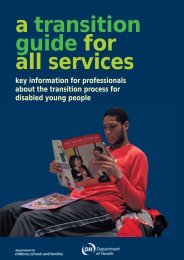NCEPOD: Trauma - Who Cares? - London Health Programmes
NCEPOD: Trauma - Who Cares? - London Health Programmes
NCEPOD: Trauma - Who Cares? - London Health Programmes
Create successful ePaper yourself
Turn your PDF publications into a flip-book with our unique Google optimized e-Paper software.
MethodQuestionnaires and casenotesThere were three questionnaires used to collect data forthis study, two clinical questionnaires per patient and oneorganisational questionnaire per site.1. A&E clinician questionnaireThis questionnaire was sent to the A&E clinician in charge ofthe patient’s initial resuscitation. Information was requestedconcerning the mode and time of arrival, initial traumaresponse, timeliness of investigations and hospital transfers.2. Admitting consultant questionnaireThis questionnaire concerned information on the locationand consultant specialty to which the patient was admitted.It also contained information on surgical procedures, patientoutcome and secondary transfers.3. Organisational questionnaireThis questionnaire concerned data on the staff, departments,facilities and protocols for each participating hospital.Information was collected at the hospital level as it gave abetter indication of the facilities available for a patient at thelocation where they were receiving care, rather than all thefacilities available within the trust as a whole.The organisational questionnaire was sent to the medicaldirector for completion. If, after a reminder, it was notreturned to <strong>NCEPOD</strong> a copy was sent to the <strong>NCEPOD</strong> localreporter of that hospital. Clinical questionnaires were eithersent to the <strong>NCEPOD</strong> local reporter for dissemination ordirectly to the clinician involved, depending on the choice ofthe hospital local reporter. However, whichever method wasused, it was requested that the completed questionnaireswere returned directly to <strong>NCEPOD</strong>.It had been hoped at the outset of the study that, in additionto these questionnaires, some information not otherwiseavailable regarding the prehospital management of patientscould be obtained from a questionnaire completed byambulance crews. However, it proved diffi cult to agree thiswith ambulance services, partly due to employment contractissues and partly due to reorganisation of ambulance trusts.Therefore, assessment of prehospital care has been acquiredfrom:a) The patient report form (PRF); completed by ambulancecrews at the scene and en route, a copy of which shouldbe available in the medical records.b) Advisors’ assessments of the prehospital care followingreview of both the PRF and clinical records andquestionnaires completed by the clinicians relatingto hospital management.To complement the data available from the abovequestionnaires, copies of all the casenotes for patients’fi rst 72 hours in hospital were requested. If the patient wastransferred within 72 hours, the casenotes from the receivinghospital were also requested.Advisor groupA multidisciplinary group of advisors was recruited to reviewthe casenotes and associated questionnaires. The group ofadvisors comprised clinicians from the following specialties:emergency medicine, anaesthetics, general surgery, intensivecare medicine, maxillofacial surgery, neurosurgery, nursing,paediatrics, plastics, orthopaedics and vascular surgery.For each case reviewed, the advisor completed anassessment form. This allowed both quantitative andqualitative analysis of the advisor’s opinion.18
















